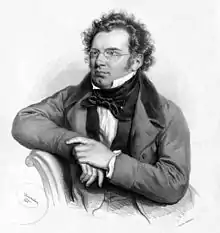Ständchen, D 920 (Schubert)
"Ständchen", D 920/921 (also known as "Notturno") is a part song for alto solo, chorus & piano, by Franz Schubert. He composed it in Vienna in July 1827, setting words by Franz Grillparzer ("Zögernd leise, in des Dunkels nächt'ger Hülle").[1]

Schubert wrote two versions, for male and female chorus, originally catalogued as:
- D 920, for alto solo, TTBB chorus & piano[1]
- D 921, for alto solo, SSAA chorus & piano, Op. 135(p)[2]
The latest update of Deutsch's catalogue places both versions under D 920, and D 921 is no longer used.
History
The poem which Schubert set was specially commissioned from Franz Grillparzer by Anna Fröhlich, a singing teacher in Vienna, to celebrate the birthday (or name-day) of her pupil Louise Gosmar. Fröhlich showed Grillparzer's poem to Schubert and asked him to set it to music, who obliged within a few days with the version for mezzo-soprano and men's voices (D. 920 in Otto Deutsch's chronological catalogue).
However, Fröhlich was unhappy because she wanted a setting for Gosmar to sing with her female friends. So Schubert swiftly produced a re-scored version with SSAA chorus, D. 921. The composer failed to turn up at the public performance and had to be fetched from a nearby beer-house.[3][4]
Schubert only set two other poems by Grillparzer: "Bertas Lied in der Nacht", D 653, and "Mirjams Siegesgesang", D 942.
Manuscripts and publication
The version with women's choir was published in 1839 or 1840 by Anton Diabelli, as "Ständchen", Op. [posth.] 135.[5] The title may be Diabelli's own: the extant autograph of D 920 (men's choir version, July 1827) is headed 'Chor mit Alt=Solo / Gedicht von Grillparzer'.[6]
References
- Notes
- Deutsch 1978, p. 587.
- Deutsch 1978, p. 588.
- Flower 2013, pp. 187-9.
- Dahms 1918, pp. 240-241.
- "D 920 Ständchen (op. posth. 135)". Schubert Online (1st ed.). Retrieved 18 December 2020.
- "D 920 Ständchen (op. posth. 135)" (autograph). Schubert Online. Retrieved 18 December 2020.
- Sources
- Dahms, Walter (1918). Schubert (in German). Berlin: Schuster & Loeffler.
- Deutsch, Otto (1978). Franz Schubert, thematisches Verzeichnis seiner Werke in chronologischer Folge (in German). Kassel: Bärenreiter. ISBN 9783761805718.
- Flower, Newman (2013). Franz Schubert - The Man And His Circle. Read Books Ltd. ISBN 9781473383500.
External links
- Ständchen, D 920 for TTBB, and D 921 for SSAA at IMSLP